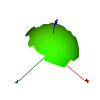That's a nice reference. Another reference isThe calibration will from my knowledge compensate for magnetic disturbances from the drone itself and local deviations. Most likely the World Magnetic Model is implemented to account for declination from true north. It is a complicated process that tries to make a sphere out of a twisted measured field.
A good link here that describes the process.
Magnetometer Calibration - MATLAB & Simulink
Magnetometers detect magnetic field strength along a sensor's X,Y and Z axes.www.mathworks.com
Hakon
Compensating for Tilt, Hard-Iron, and Soft-Iron Effects
The calibration doesn't compensate for local deviations. It can only compensate for magnetic effects that are on the AC itself. The hard and soft iron effects mentioned in the reference are due to magnetic effects on the AC.
You might find this interesting. The MagData player in CsvView presents the magnetic field strength as a colored surface of a sphere. The effects of an uncalibrated compass are easily seen. It was a science fair project that never really proved to be useful. But, it's great eye candy.
MagData Player











